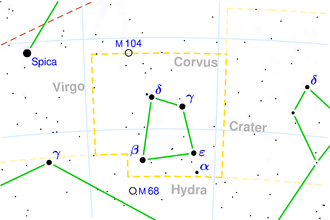NGC 4756
| Galaxy NGC 4756 |
|
|---|---|
|
|
|
| AladinLite | |
| Constellation | Crow |
|
Position equinox : J2000.0 , epoch : J2000.0 |
|
| Right ascension | 12 h 52 m 52.6 s |
| declination | -15 ° 24 ′ 48 ″ |
| Appearance | |
| Morphological type | SAB (s) 0 ^ 0 ^? / cD |
| Brightness (visual) | 12.4 mag |
| Brightness (B-band) | 13.4 mag |
| Angular expansion | 1.7 ′ × 1.3 ′ |
| Position angle | 50 ° |
| Surface brightness | 13.1 mag / arcmin² |
| Physical data | |
| Affiliation |
Abell 1631 NGC 4756 Group LGG 306 |
| Redshift | 0.013599 ± 0.000063 |
| Radial velocity | 4077 ± 19 km / s |
|
Stroke distance v rad / H 0 |
(177 ± 12) · 10 6 ly (54.2 ± 3.8) Mpc |
| history | |
| discovery | Wilhelm Herschel |
| Discovery date | February 8, 1785 |
| Catalog names | |
| NGC 4756 • PGC 43725 • MCG -02-33-039 • 2MASX J12525262-1524478 • GC 3276 • H III 281 • h 1464 • LDCE 921 NED029 | |
NGC 4756 is an elliptical cD galaxy of the Hubble type E / S0 in the constellation Raven south of the ecliptic . It is estimated to be 177 million light years from the Milky Way and about 90,000 light years across .
The galaxies IC 829 and IC 3831 are located in the same area of the sky .
The object was discovered on February 8, 1785 by Wilhelm Herschel with an 18.7-inch reflector telescope, who described it as “vF, pS, resolvable”.
